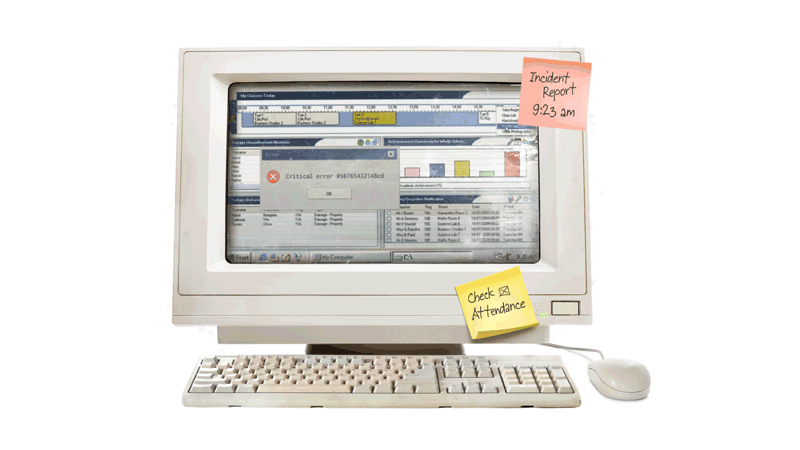A student information system (SIS) is a software application used to manage, track and store student and staff data. Historically, SIS has been used to record basic personal details such as name, address, phone number, date of birth, and attendance records. However, with the introduction of advanced technology in recent years, modern SIS is often able to provide more comprehensive services like tracking academic progress and financial aid applications.
The history of Student Information Systems (SIS) can be traced back to the 1960s and 1970s, when universities began using technology to track and store student data. These systems were rudimentary, collecting basic information such as name and date of birth. As technology advanced, so too did SIS capabilities. In the late 1980s and early 1990s, SIS implementations began to diversify with a focus on tracking student grades, attendance records, and even financial aid applications.
By the 2000s, SIS had become an integral part of everyday life for schools of all grade levels. Today’s SIS has a wide range of other features that make them more useful than ever before.
These include:
- Automated notifications for events such as class cancellations or exam results
- The ability to manage multiple student types
- Tools for customizing user profiles
- Detailed reporting capabilities
- Online assessments
- Tools for managing admission and enrollment
- Calendar integration
- e-learning support
- Faculty evaluation tools
- Extracurricular activities tracking capabilities
- Mobile applications for accessing important information on the go
How Student Information Systems Affect Staff
Student Information Systems have a significant impact on staff productivity. Depending on the size and complexity of a school, SIS can help to streamline daily operations and save time for staff members. With access to comprehensive student data, such as attendance records and grades, teachers can easily create and track progress reports for each student. Additionally, an SIS can help teachers manage their classrooms more efficiently. For instance, they can use the system to post homework assignments and take electronic attendance rather than relying on paper forms or manual check-ins. Features such as automated notifications allow schools to quickly inform students or parents about important dates or events without having to manually send out emails or make phone calls. In addition to increasing staff efficiency, SIS also provide support for professional development opportunities such as conferences or workshops. Through these systems, teachers can easily access resources that will help them stay abreast of new trends in education technology and improve their teaching skills. Overall, Student Information Systems are invaluable tools that allow schools to operate more efficiently while simultaneously supporting faculty development opportunities. By giving staff members access to comprehensive student data and providing automated notifications, these systems reduce administrative workloads while helping educators stay informed on the latest educational trends and techniques.How Student Information Systems Impact Students
Students are the main beneficiaries of SIS, as they provide an easy way for them to keep track of their academic progress and access important information. Through the system, students can easily view and update critical data such as grades, attendance records, assignments, and test scores. Student Information Systems allow students access resources with ease even when they’re not physically in school. With online portals and mobile applications available, students can read and submit assignments on the go or review notes from previous lectures without having to be in the classroom. Moreover, Student Information Systems provide useful features that are tailored specifically to student needs. Automated notifications can help remind students about upcoming deadlines or tests so that they don’t fall behind on their studies. Additionally, these systems often provide custom reports which give detailed insights into student performance so that educators can more effectively identify areas of improvement and create targeted solutions. Finally, advanced SIS solutions are often equipped with security features which protect student data from unauthorized access. By preventing unauthorized users from accessing personal information such as grades or contact details, schools can ensure that student privacy is protected at all times. Overall, Student Information Systems have a tremendous impact on student learning by providing them with valuable tools designed specifically for their needs. By giving them easy access to important data and resources while also keeping their information secure, these systems make it easier for students to stay organized while helping educators better understand how best to support individual progress over time.The Downside of Using Legacy Student Information Systems
Despite their potential to facilitate efficient management of student information and educational activities, legacy or old SIS can present some unexpected challenges for schools. Here are just a few reasons why using a legacy system may not be the best option:Maintenance and Support Challenges
As older SIS become increasingly outdated, it can be difficult to find adequate support and resources needed for maintenance. Many engineers and support technicians are aging out of the workforce or moving into other roles. Furthermore, there may not be any guarantee that the system will continue to work as expected over time.Costs
Legacy systems are often inefficient and require more processing power than modern ones do. This means they tend to be more expensive to operate in comparison, especially when factoring in regular maintenance costs. These costs can spiral out of control as fewer and fewer individuals and consultants possess the expertise to support older, outdated SIS.Security Concerns
Many legacy SIS lack security features that protect against data breaches or unauthorized access. Schools should take into account the risks associated with such vulnerabilities before making a decision about which platform to use. If the publisher is no longer providing patches and updates then the SIS is becoming more and more vulnerable to breaches with each passing day.Performance Issues
It is not uncommon for legacy systems to experience slowdowns due to their outdated hardware and software. This can be frustrating for both staff and students, as it can lead to delays in completing tasks or accessing information. New software and technology is optimized for performance. This can include taking advantage of cloud computing, delivery in a SaaS model, or other technological advancements that benefit the user. Legacy SIS running on on-prem infrastructure or using an obsolete database will only continue to get slower until it stops working altogether.Training New Team Members
As legacy systems require specialized knowledge and skills, training new team members on the system can be time-consuming and costly. Schools should consider whether it is more efficient to invest in modernizing their SIS or simply find a different platform that requires less maintenance and support.The Case for Modernizing Your SIS
Ultimately, when deciding which student information system to use, schools must weigh the pros and cons of using a legacy SIS against those of newer solutions. Although there may be some benefits associated with using an older system, such as familiarity with its features or a lack of resources to train on a new system, many of these are outweighed by the drawbacks. The maintenance and support challenges, security concerns, performance issues, and training time required for new team members all make it difficult to recommend using a legacy system over modern solutions. Schools should carefully consider their options before making any decisions and ensure they select a SIS that meets both their budget and needs. With adequate research and careful consideration of the risks associated with each option, schools will be able to find an SIS that is both secure and cost-effective. Alma’s SIS solutions are cost-effective, simple to integrate, and include the features and benefits necessary to quickly prove out a fantastic return on investment. Contact Alma today to schedule a tour of our student information system.Ready to learn more about Alma?


